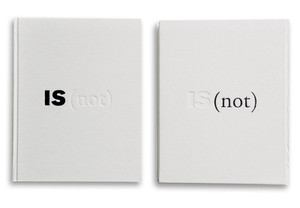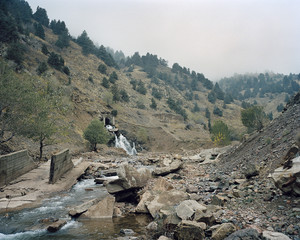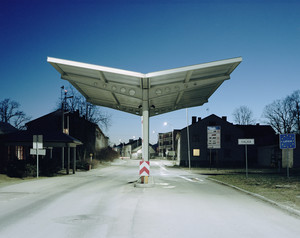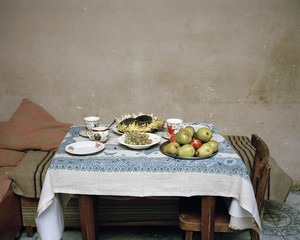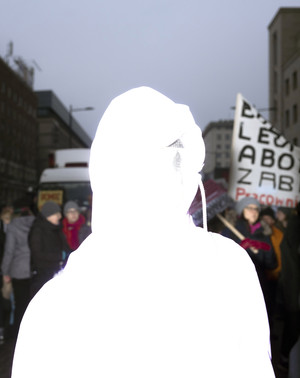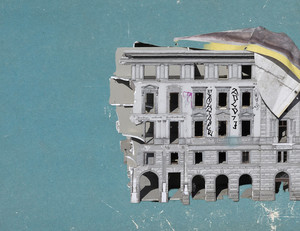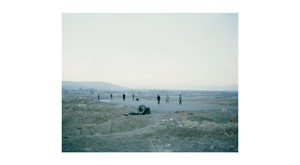



Photographers: Jan Brykczynski, Michal Luczak, Rafal Milach, Adam Panczuk, Agnieszka Rayss
Text by: Sindri Freysson, Hermann Stefansson, Kristin Heida Kristinsdottir, Sigurbjorg Prastardottir, Huldar Breidfjord
Editor / curator: Andrzej Kramarz
Designer: Ania Nalecka / Tapir Book Design
Language of text: English / Icelandic / Polish
ISBN: 978-83-927485-8-8
Publisher: Sputnik Photos
Print run: 1000
Nr of special edition copies: 300
City of publisher: Warsaw
Year published: 2011
No. Of pages: 240
Distributor: Sputnik Photos
IS(not) / ‘Earth Bleeds Water’, Agnieszka Rayss
Due to the special geological location of Iceland, the high concentration of volcanoes in the area is often an advantage with respect to the generation of geothermal energy, heating and the production of electricity. In the winter, pavements near these areas (such as Reykjavík and Akureyri) are heated up.
Producing energy is not the only use of geothermal energy in Iceland. In every community, there is a high-quality outdoor swimming pool filled with warm geothermal water, hot tubs and other facilities, where people meet to exercise and chat. They are open year-round, regardless of the weather.
Visiting outdoor swimming pools in Iceland is a unique experience, particularly when the outside temperature is a few degrees below zero.
text © Sigurbjörg Þrastardóttir
IS (not) / ‘Very hidden people’, Adam Pańczuk
Modern Icelanders. Most of them don’t believe in God, the majority can’t imagine joining the EU, many deny the world’s economic rules, but there is something beyond nature that they do believe in and respect. Hiddenfolk, the hidden people – elves. In 2006 and 2007, the social science department of the University of Iceland conducted surveys on Icelanders’ beliefs in occult phenomena. The results showed that 62% of those asked believed that it was possible, likely or certain that elves and hidden folk existed. In times governed by economic calculations, Icelanders spend extra millions of ISK building national roads, not according to the shortest path, but around elves’ rocks or hills. There were enough cases of broken tools, machines, arms and legs to warn against contradicting the wishes of the elves. After the economic crisis, Hiddenfolk were again, as in ancient times, the symbol of a distressed nation’s longing for a better life and a magical solution to its problems. It is the nation's literary creation in some sense, but also its distorted mirror image.
Text © Sindri Freysson
Is(not) / ‘In the car with R’, Rafał Milach
“To do the Ring” is an Icelandic expression that generally refers to travels on Route 1, the highway that encircles the country. To travel this road is something that most Icelanders do at some point in their lives, and some even prefer to do it every summer. The reasons for going are of course different, but many people probably set out with the idea that on the way they’ll learn more about their fellow Icelanders or native beliefs, that they’ll see more of their country. However, travelling on the Ring Road is a risky business. On the way, you might learn something about yourself or your family, regardless of whether they live close to the highway or share the car with you. A lot of journeys on the Ring Road have ended in divorce, while babies have been born in the wake of others. And there is no guarantee that you’ll learn more about Iceland on the way. When it comes to travelling (and photography?), what you see matters less than the way you look at it.
We did the Ring. In May of 2010, driving a green Opel Astra Station (1994 model). And we were back ten days and 1450 kilometers later.
text © Huldar Breidfjord
Is(not) / ‘To be an island’, Michał Łuczak
The Icelandic word einangrun consists of two stems. The first part of the word is ein, which means “1”, while the second part is angrun, which means “sadness” or “sorrow”, and is related to words like “angurvaerd” (“melancholy”) and “angur” (“sorrow”). In other words, einangrun literally means the sadness or sorrow of being alone. Corresponding words in other languages are constructed differently. Many languages of the European continent, probably most of them, have concepts that derive from the Latin word “isola”, meaning “island”. “Isolation” means to be like an island in some sense.
Text © Hermann Stefánson
Is(not) / ‘Arnes’, Jan Brykczyński
A small community of farmers who have chosen to raise sheep only. The people live off the land, as Icelanders have for hundreds of years. Far from bright lights and big cities, people in the Árnes region live surrounded by steep mountains and waves crashing on the shore. In the Árnes region, 38 people live in 15 houses all year round. There are more than 2700 sheep in the whole area.
text © Kristín Heiða Kristinsdóttir
Exhibitions / Is(not)
2016 Contemporary Art Center, Baku/Azerbaijan
2012 Sirius Art Center in Cobh, Ireland
2011 Galeria Szara in Cieszyn, Poland
2011 Miedzynarodowy Festiwal Filmow Krotkometrazowych ZubrOFFka in Bialystok, Poland
2011 Gdanska Galeria Fotografii in Gdansk, Poland
2011 Galeria Fotografii B&B in Bielsko-Biala, Poland
2011 Bochenska Gallery in Warsaw, Poland
2011 Menningarmiðstöðin Gerðuberg in Reykjavik, Iceland
2011 LA Art Museum / Hveragerdi, Iceland
2011 Hof / Akureyri, Iceland
Prizes / Is(not)
Syngenta Photography Award 2011, Jan Brykczyński (Professional Commission First Prize Winner)
POYi The Best Photo Book Awards 2011, Rafal Milach and Huldar Breifjord among the finalists for the book ‘In the car with R’
Grand Press Photo Award 2011, Adam Panczuk (category: People, 1st Prize)
New York Photo Festival 2011, Rafal Milach (Grand Prize)
Sony World Award 2012, Jan Brykczynski (3rd Prize)
BZ WBK Press Foto 2011 for Agnieszka Rayss (category Civilisation 2nd Prize)
Radiowa Trojka award 2011: The Book of the Year (nomination for the book ‘IS(not)’)
Kulturysta Roku 2011 nomination for the project ‘IS(not)’
